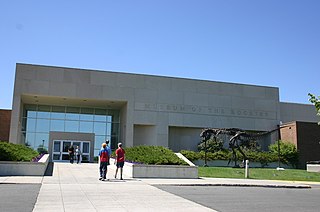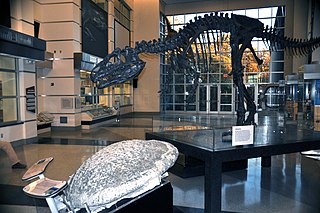Related Research Articles

Lufkin is the largest city in Angelina County, Texas and the county seat. The city is situated in Deep East Texas and is 60 mi (97 km) west of the Texas- Louisiana state line. Its estimated population is 35,021 as of July 1, 2019.

The Field Museum of Natural History (FMNH), also known as The Field Museum, is a natural history museum in Chicago, Illinois, and is one of the largest such museums in the world. The museum is popular for the size and quality of its educational and scientific programs, and its extensive scientific specimen and artifact collections. The permanent exhibitions, which attract up to 2 million visitors annually, include fossils, current cultures from around the world, and interactive programming demonstrating today's urgent conservation needs. The museum is named in honor of its first major benefactor, Marshall Field, the department-store magnate. The museum and its collections originated from the 1893 World's Columbian Exposition and the artifacts displayed at the fair.

The American Museum of Natural History is a private 501(c)(3) natural history museum on the Upper West Side of Manhattan in New York City. In Theodore Roosevelt Park, across the street from Central Park, the museum complex comprises 26 interconnected buildings housing 45 permanent exhibition halls, in addition to a planetarium and a library. The museum collections contain over 34 million specimens of plants, animals, fungi, fossils, minerals, rocks, meteorites, human remains, and human cultural artifacts, as well as specialized collections for frozen tissue and genomic and astrophysical data, of which only a small fraction can be displayed at any given time. The museum occupies more than 2×106 sq ft (190,000 m2). AMNH has a full-time scientific staff of 225, sponsors over 120 special field expeditions each year, and averages about five million visits annually.

The National Museum of Natural History is a natural history museum administered by the Smithsonian Institution, located on the National Mall in Washington, D.C., United States. It has free admission and is open 364 days a year. In 2021, with 7.1 million visitors, it was the eighteenth most visited museum in the world and the second most visited natural history museum in the world after the Natural History Museum in London. Opened in 1910, the museum on the National Mall was one of the first Smithsonian buildings constructed exclusively to hold the national collections and research facilities. The main building has an overall area of 1.5 million square feet (140,000 m2) with 325,000 square feet (30,200 m2) of exhibition and public space and houses over 1,000 employees.

The Carnegie Museum of Natural History is a natural history museum in the Oakland neighborhood of Pittsburgh, Pennsylvania. It was founded by Pittsburgh-based industrialist Andrew Carnegie in 1896. Housing some 22 million specimens, the museum features one of the finest paleontological collections in the world.

The Natural History Museum of Los Angeles County is the largest natural and historical museum in the western United States. Its collections include nearly 35 million specimens and artifacts and cover 4.5 billion years of history. This large collection comprises not only of specimens for exhibition, but also vast research collections housed on and offsite.

Naturalis Biodiversity Center is a national museum of natural history and a research center on biodiversity in Leiden, Netherlands. It was named the European Museum of the Year 2021. Although its current name and organization are relatively recent, the history of Naturalis can be traced back to the early 1800s. Its collection includes approximately 42 million specimens, making it one of the largest natural history collections in the world.

Museum of the Rockies is a museum in Bozeman, Montana. Originally affiliated with Montana State University in Bozeman, and now also, the Smithsonian Institution. The museum is largely known for its Paleontological collections as well as having the largest collection of North American Dinosaur fossils in the United States. They also possess the largest Tyrannosaurus skull ever discovered, as well as the thigh bone of a Tyrannosaurus Rex that contains soft-tissue remains. The museum is part of the Montana Dinosaur Trail and is Montana's official repository for Paleontological specimens.

The Houston Museum of Natural Science is a natural history museum located on the northern border of Hermann Park in Houston, Texas, United States. The museum was established in 1909 by the Houston Museum and Scientific Society, an organization whose goals were to provide a free institution for the people of Houston focusing on education and science. Museum attendance totals over two million visitors each year. The museum complex consists of a central facility with four floors of natural science halls and exhibits, the Burke Baker Planetarium, the Cockrell Butterfly Center, and the Wortham Giant Screen Theatre. The museum is one of the most popular in the United States and ranks just below New York City's American Museum of Natural History and Metropolitan Museum of Art and the M. H. de Young Memorial Museum in San Francisco in most attendance amongst non-Smithsonian museums. Much of the museum's popularity is attributed to its large number of special or guest exhibits.

The Burpee Museum of Natural History is located along the Rock River in downtown Rockford, Illinois, United States, at 737 North Main Street.
The North Carolina Museum of Natural Sciences (NCMNS) is the largest museum of its kind in the Southeastern United States. It is the oldest established museum in North Carolina, located in Raleigh. In 2013, it had about 1.2 million visitors, and it was the state's most visited museum or historic destination among visitors.
The New Mexico Museum of Natural History and Science is a natural history and science museum in Albuquerque, New Mexico near Old Town Albuquerque. The Museum was founded in 1986. It operates as a public revenue facility of the New Mexico Department of Cultural Affairs.

Sue is the nickname given to FMNH PR 2081, which is one of the largest, most extensive, and best preserved Tyrannosaurus rex specimens ever found, at over 90 percent recovered by bulk. FMNH PR 2081 was discovered on August 12, 1990, by American explorer and fossil collector Sue Hendrickson, and was named after her.

"Stan", also known by its inventory number BHI 3033, is a Tyrannosaurus rex fossil found in the Hell Creek Formation in South Dakota, just outside of Buffalo in 1987, and excavated in 1992. It is the fifth most complete T. rex fossil discovered to date, at more than 70% bulk. In October 2020, the fossil was sold for $31.8 million at auction, making it the most expensive dinosaur specimen and fossil ever sold. In March 2022 Abu Dhabi's Department of Culture and Tourism stated that they had acquired Stan and were planning on displaying the fossil at a new museum of natural history slated to open in 2025.

Tyrannosaurus is one of the most iconic dinosaurs and is known from numerous specimens, some of which have individually acquired notability due to their scientific significance and media coverage.

A creationist museum is a facility that hosts exhibits which use the established natural history museum format to present a young Earth creationist view that the Earth and life on Earth were created some 6,000 to 10,000 years ago in six days. These facilities generally promote pseudoscientific biblical literalist creationism and contest evolutionary science. Their claims are dismissed by the scientific community.

The Virginia Museum of Natural History is the state's natural history museum located in Martinsville, Virginia founded in 1984. The museum has several different award-winning publications, is affiliated with the Smithsonian Institution, and has more than 22 million items. This includes the first intact stromatolite head ever found in Virginia, which is one of the largest complete 'heads' in the world, at over 5 feet in diameter and weighing over 2 tons.

The Brazos Valley Museum of Natural History is a science, nature, and cultural history museum in Bryan, Texas, United States. The museum also maintains memberships in American Alliance of Museums, Natural Science Collections Alliance, and the Society for the Preservation of Natural History Collections.
The Sintra Natural History Museum is a museum of natural history located in the historic center of the village of Sintra. The museum has both at national and international level due to the quality and rarity of many of its exhibits.

The Museum of Idaho (MOI) is a history and science museum in downtown Idaho Falls, Idaho. The museum features exhibits, collections, and programs focused on the social and environmental history of Idaho and the Intermountain West, as well as prominent traveling exhibits on a variety of subjects. Its tagline is “bringing the world to Idaho, and Idaho to the world”.
References
- ↑ Kirkland, Ariel (September 8, 2012). "Naranjo Museum of Natural History cuts ribbon on its new digs". The Lufkin News. Retrieved May 14, 2022.
- ↑ Smith, Chuck (May 1, 2014). "Lufkin natural history museum lands NASA moon rock exhibit". Red River Radio. Retrieved May 14, 2022.
- ↑ Viggiano, Brooke (June 22, 2021). "5 Must Do Things in Lufkin" . Retrieved May 14, 2022.
- 1 2 Lynn, Penny. "Texas Gems & Backyard Treasures: Lufkin's Naranjo Museum of Natural History". Palestineherald.com. Retrieved April 7, 2022.
- ↑ ""Bubba-Rex" goes on exhibit at Lufkin's Naranjo Museum of Natural History". KTRE. March 22, 2016. Retrieved May 14, 2022.
- ↑ "T-Rex dinosaur fossil arrives at Naranjo Museum of Natural History". KTRE. Retrieved May 14, 2022.